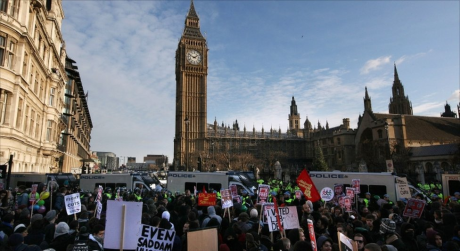London on lockdown: How social media spurred student protests

London is currently on lockdown after student protests opposing the rise in university tuition fees became uncontrollable. Social media was and continues to be a significant conduit to organising student protests, scenes the UK has not seen since the 1970's.
MP's have voted by a narrow majority to triple tuition fees in England, with devolved governments in Scotland and Wales being given free or significantly reduced university education. Social media has been central in rallying student support to protest the change in tuition fees, with many arguing it will be more expensive than the US college system.

Student union leaders and protest organisers "are not condoning violence" and appealing for calm, after violence broke out caused by a tiny minority of breakaway protesters. But social media has been a key organisation feature in breaking away from the main protests in Trafalgar Square and Parliament Square in Mumbai-style citizen reporting.
So far during this protest:
- Over a million students in the UK have staged peaceful protests on their campuses, signed petitions, joined Facebook groups and dominated Twitter with hashtags and messages of support.
- Over 25,000 students descended on central London today to protest peacefully, with an estimated 50,000 students at the first rally organised by the National Union of Students last month.
But as darkness fell on the capital city, police had been deployed in the hundreds after protesters stormed the streets of London and broke away from predetermined routes. Only a small number of militant protesters caused damage to the Treasury and Supreme Court, which is now being protected by riot police.
The protests prior to and including today were organised through Facebook groups; decentralised in nature from individual student union organisations at universities around the country, all working towards the same goal of peaceful demonstrations. Lauren Crowley, vice-president of Kent Union, explained how.
"Kent Union mobilised 500 students at the University of Kent to attend the #demo2010 on 10th November that was partly undertaken with face-to-face meetings with students, but mostly through the use of email lists, Facebook and Twitter. We had 700 students' sign a petition in just two days through Facebook and email, showing just what we can achieve by clever and target used of social networking."
Social media has played a major part in organising the directions of many protesters today. Above all, by following hashtags you can follow in diary-like updates the events in real-time on #fees and #dayx3, even if you are on the other side of the world without access to the live news channels.
Last year when I questioned how useful Twitter could have been in a terrorist attack like the London bombings with citizen journalism and community updates, a near exact real-life example has been demonstrated today with hotspots being broadcast on social media pages.
But as student union's are increasingly communicating with their representatives through the means of social media, this sets a prominent example to business leaders in how to communicate effectively with the younger Generation Y demographic.
Most student protesters today and prior to today's events have been 'kettled' - penned in by riot police to restrict movement, causing extreme anger and perpetuated violence upon their release. The Metropolitan Police are now appealing for third-parties with 'any exert of control' to try and dampen civil unrest as police resources become increasingly stretched.
The same violent protesters threw paint and rocks at the car carrying heir to the throne, Prince Charles and his wife Camilla. A window was broken in a 'severe breach in Royal security' shortly before the car drove away with a police convoy without any injury to the Royal couple.
For now, there is no let-up in sight for the evening. As it nears nine-o'clock in the evening, students are still being kettled, restricted from movement, and violent disorder is still being caused by a small minority of violent extreme protesters piggybacking off the peaceful mentality of the vast majority.